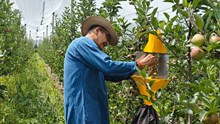
Soursop botanically known as (Annona muricata) and commonly known as Graviola, is an evergreen tree that is a member of the Annonaceae family. This originated in Central America, grows well in tropical and subtropical climates, and holds great potential for farmers in places like Southern India. The demand for this fruit has increased globally due to its reputation as a superfruit that improves health, especially because of its content of annonaceous acetogenins, which are thought to have anti-cancer effects. Farmers can access expanding both local and global markets by growing soursop.
Climate and Soil Requirements
Soursop prefers well-drained, semi-dry soils at elevations up to 300 meters above sea level. It grows best in temperatures ranging from 21°C to 30°C but is highly sensitive to frost. Though productive orchards can exist at up to 1,100 meters, extreme cold or frost may interrupt fruiting or defoliate the tree. The tree prefers tropical climates but can adapt to various conditions with careful management, making it suitable for many parts of Southern India. Common varieties of soursop are often classified into three main groups based on flavor: sweet, sub-acid, and acid. These are further divided based on shape-round, oblong, heart-shaped, or angular-and flesh texture, which ranges from soft and juicy to firm and fibrous.
While no standardized cultivars dominate, some local selections may show traits such as higher yields, sweeter pulp, or superior resistance to environmental challenges. These traits offer the potential for further cultivar development in farming.
Regional Adaptation of Soursop Farming
Soursop grows well in tropical and subtropical areas, It can easily be grown in regions like Tamil Nadu, Karnataka, Kerala, and Andhra Pradesh in Southern India. It grows well within an elevation of up to 300 meters. The ideal temperature varies between 21°C and 30°C with good drainage. It is sensitive to frost, this plant will thrive in an area with climatic stability.
Propagation and Planting Techniques
Soursop can be propagated through seeds or budding. While grafted seedlings are often preferred for uniformity and faster yields, seeds should be sown immediately after extraction to ensure viability. Pre-sowing treatments, such as soaking and selecting sunken seeds, can enhance germination. Proper land preparation includes deep plowing, leveling, and digging pits (60 × 60 × 60 cm) filled with a mix of topsoil and compost. Early evening or cloudy days are ideal for transplanting, and young plants should be watered immediately to ensure establishment.
Training and Pruning for Healthy Growth
The tree naturally forms a symmetrical, conical shape, making it suitable for the central leader system. Fruits grow on lateral branches, hanging down for easy harvesting. Pruning is needed minimally only for removing diseased, weak, or interlocking branches. Proper air circulation and light penetration are important for increasing fruit production.
Nutrient Management and Irrigation
Fertilization is essential for successful soursop cultivation. Fertilizer dosage of 40 g of nitrogen and 60 g of potassium should be applied according to soil analysis for a year old plants and for mature trees the dosage are 180 g of nitrogen, 120 g of phosphorus, and 180 g of potassium per year, divided into three doses during the rainy season. Watering is essential on a regular basis, particularly during the dry season in order to preserve plant health and maximum harvests.
Harvesting and Post-Harvest Management
Soursop fruits are harvested when grown to their full size and are slightly yellowish-green but still soft. They can’t be left to soften on the trees as once it is mature it will fall off and get damaged. Fruits should be stored at room temperature for 4–7 days for maturation purposes after its harvest. Proper handling minimizes bruising, and refrigeration can extend shelf life by 2–3 days, though below 15°C may cause chilling injuries if left for a longer period of time.
Health Benefits and Market Demand
The fruits of soursop are rich in vitamins B and C, calcium, and phosphorus, which makes it a nutritious food. The medicinal properties of this fruit is for fighting cancer, gout, and inflammation, and leaves and seeds are used for traditional medicine in treating head lice, parasites, and even liver problems. Due to its increased recognition of the health benefits, the demand for soursop and its by-products such as dried leaves for tea, has seen a hike and is sold at good prices both locally and in the export market.
Economic Benefits and Export Opportunities
Soursop farming has a high return on investment. Increasing demand for the fruit, either fresh or for medicinal uses, has increased its value in the market. Fresh soursop sells at premium price in the local markets; the processed products, such as dried leaves, juices, and teas, are gaining popularity in online sales. Export opportunities increase with tropical America and Europe. Average yields per orchard maintained for one year is up to 25–40 kg for one tree while the price earning goes up to ₹300-₹500. That makes the soursop as a crop of good monetary return for farming.High-density planting methods can further boost yield, maximizing profitability per hectare.
For farmers looking to diversify their crops and boost revenue, soursop growing is a potential endeavor. It is a diversified crop to grow because of its resilience to tropical conditions and the growing demand for fruits that promote health. Soursop farming not only helps maintain financial stability but also promotes global health and wellbeing. Soursop provides a productive way for farmers to follow the global trend toward sustainable and health-conscious agriculture.
















